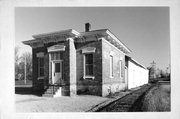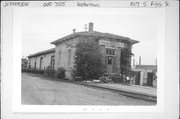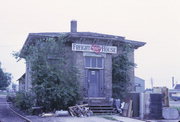| Additional Information: | A 'site file' exists for this property. It contains additional information such as correspondence, newspaper clippings, or historical information. It is a public record and may be viewed in person at the State Historical Society, Division of Historic Preservation.
The brick section of this building was originally an office for the Chicago, Milwaukee, and St. Paul Railroad. In the early twentieth century, the attached section was added and used as a freight house.
The Chicago, Milwaukee, and St. Paul Railroad (CM&SP) was the first railroad link to come to Watertown. The company began as the Milwaukee and Watertown Railroad, incorporated in 1853. This company completed track from Milwaukee to Oconomowoc by 1854 and built track to Watertown in 1855. The line was not efficient and many businesspeople complained about the infrequent service. In 1856, the railroad consolidated with the Watertown and Madison and the LaCrosse and Milwaukee. It was sold in 1858 and became part of the Milwaukee, Watertown and Baraboo Railroad. In 1861 the line became the Milwaukee and Western and later part of the CM&SP. This railroad had a passenger depot and small office building originally at the end of S. Fifth St. and at one time operated large repair shops at the end of Baxter Street. The extensive railroad repair shops burned and were not rebuilt in 1887. A roundhouse in this area also existed until the twentieth century. Sometime after 1926 it was demolished as was the passenger depot at the end of S. Fifth St. Only the small office building with its later attached freight house is left from the many resources that once were related to the CM&SP Railroad in Watertown.
The original section of this building is significant under National Register Criterion A because it is the only remaining resource associated with the historic Chicago, Milwaukee, and St. Paul Railroad, the first railroad link in Watertown.
The coming of the railroad often meant economic success for a community. I a railroad ilnk missed for a community, very often that community never grew much beyond a small village. Watertown expended much energy and money to get the railroad links, so much so that it was saddled with a railroad bond debt it could not get out from under until the end of the nineteenth century. The irony was that Watertown probably did not need to out itself in financial jeopardy to gain a railroad link. Watertown was an important interior town even without the railroad and a logical link between Milwaukee and the interior of the state. In any event, Watertown had two major railroad links in the late nineteenth century, the Chicago, Milwaukee, and St. Paul and the Chicago and Northwestern. These railroad links gave Watertown the transportation facilities it needed in the nineteenth century to support successful businesses and industries. Of the many CM&SP railroad facilities that existed in Watertown, onlt this small office building remains. While it was not the most significant of the CM&SP facilities, the fact that it is the only extant resource associated with this railroad, and the fact that it has a good deal of integrity, means that it is a significant landmark in the local history of railroad transportation in Watertown.
Constructed on an elevated foundation, this small, red brick Milwaukee-St. Paul Railroad Freight Office is characterized by broad roof ornamented by paired wooden brackets under the wide overhanging eabes and projecting wooden triangular shaped window heads as well as wooden sills with consoles under the overhang. Long, multi-paned window sashes remain on the building. A one-story entrance projecting from the facade features a sidelighted door with transom window and large triangular pediment shaped door head.
The rear one-story metal covered extension was added in the early 20th century.
The Milwaukee-St. Paul Railroad Freight Office is significant under criterion C as an example of the Italianate style. One of a very few resources associated with the early years of railroad activity in the city of Watertown, the freight office exhibits the projecting eaves, cubic shape, bracketed eaves and long windows with elaborate window heads typically associated with the Italianate style. Other good examples of the early Italianate style of commercial or industrial architecture include the Misegades Wagon Works at 202 No. Water (63-4) and the Jones and Evans building at 103-105 W. Main (72-6).
Other historic railroad buildings in the city include the Chicago-Northwestern Depot at 725 W. Main (57-11) and the depot at West and Lafayette St. (59-8). |
|---|



